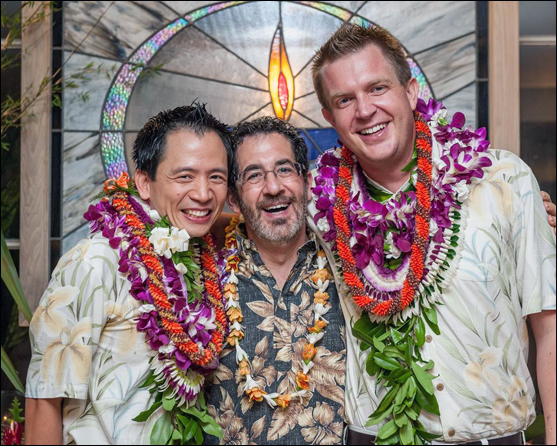
UU minister says historic 'I do' in Hawaii
Eight minutes after same-sex marriage became legal, minister and fiancé wed at First Unitarian Church of Honolulu.
Same-sex marriage became the law in Hawaii at midnight, and the Rev. Dr. Jonipher Kupono Kwong married Chris Nelson, his partner of 15 years, at 12:08 a.m. Their friend, Rabbi Peter Schaktman, performed the ceremony at the Unitarian church, a congregation that has been working for equal marriage rights in Hawaii for two decades.
During his 10-year ministry, Kwong has performed more than 50 weddings. However, he was “always the minister, never the groom,” he said. That started to change in late October when Gov. Neil Abercrombie ordered a special session of the state legislature to consider the Marriage Equality Act. The legislature overwhelmingly passed the act, which extends full marriage rights to same-sex couples, and Abercrombie signed it into law November 13.
The governor, state legislators, and more than 20 clergy members from many faith traditions attended the historic wedding of Kwong and Nelson, along with friends, family, and members of the church. “It has been an exhilarating past couple of weeks,” Kwong said.
It was a traditional wedding, Kwong said, celebrating the Hawaiian values of aloha (love), ohana (family), and lokahi (unity). The only nontraditional part was that they held the reception first, gathering for pupu, or appetizers and celebration, on Sunday evening and counting down until same-sex marriage became legal at midnight. The couple secured their marriage license online, and the rabbi pronounced them legally wed eight minutes later.
The green people
Proponents of same-sex marriage in Hawaii had nearly given up on legalized weddings this year, thinking they would have to wait until next year’s legislative session to lobby again for equal rights. However, advocates—including many members of the 150-member First Unitarian Church of Honolulu—rallied and campaigned relentlessly, kicking off campaign events this year with a concert by the activist folk duo Emma’s Revolution.
At each rally and event, Unitarian Universalists wore bright green shirts that said “Boldly growing compassion, justice, and joy” on the front, with the name and logo of the Honolulu UU church on the back. “We became known as the green people,” Kwong said.
The congregation hosted an interfaith prayer brunch in August to mobilize support. “It was an upgrade from a prayer breakfast,” said Kwong. “We felt like the rights of LGBT people needed to be upgraded to first-class benefits. Civil unions were not enough.”
(Hawaii had legalized same-sex civil unions in 2011.) At the brunch, 33 clergy of many faiths signed a statement endorsing equal marriage rights. By the time the governor called the special session in October, 70 clergy had signed on.
Members of the Honolulu UU church created their own petition, which 85 members signed. The church hosted phone banks and organized postcard drives to persuade Hawaiians to contact their legislators and urge them to support equality.
At a rally outside the capitol, Kwong spoke to the crowd, issuing a “public apology” on behalf of all spiritual leaders and religious people for the pain religion has caused to the LGBT community. “There is no excuse for spiritual violence . . . or religious violence,” he said. “There is no religion that preaches discrimination and hate that is worthy of your commitment and your hard-earned dollars. . . . There is another way.”
In November, the Rev. Peter Morales, president of the Unitarian Universalist Association, issued a statement applauding the legalization of same-sex marriage in Hawaii and Illinois, which became the 15th and 16th states with marriage equality. “I applaud the great efforts of all who helped secure this victory,” he said. “These wins for marriage equality, in particular, did not come easily. Advocates, including many Unitarian Universalists, did not give up; instead they persevered in the long campaign against intolerance and inequality.”
Seizing the moment
In 2008, Kwong and Nelson were living in California when same-sex marriage was first legalized there. Kwong said his mother urged the couple go to a courthouse and marry then, but they decided to wait so they could plan a proper wedding.
They sat together in the Hawaii House of Representatives in October listening to hour upon hour of testimony, as people shouted outside the building to let voters decide. Kwong and Nelson left midway through the testimony to have a celebratory dinner marking their 15th anniversary. They realized that if same-sex marriage passed in Hawaii, it would be the 15th U.S. state. That was a sign to them that they should get married. And soon.
Nelson said he regretted the decision to wait in California, where voters then passed Proposition 8, reversing the court’s decision to legalize gay marriage. “It took a few more years for Californians to get marriage back,” said Nelson. “Now that we have it here in Hawaii, we’re not waiting anymore.”
A week after the bill was signed into law, Kwong helped to lead an interfaith “service of gratitude for marriage equality,” along with three dozen other clergy at the Cathedral of St. Andrew in Honolulu. A religious celebration of the law was fitting, said Kwong: “Religion played a front-and-center role in this debate. The fact that over 100 religious leaders throughout Hawaii endorsed marriage equality speaks volumes.”
Kwong has begun to receive email inquiries from people seeking to hold same-sex weddings at the church. “It is a cool venue to have a wedding,” Kwong said, “where Obama went to Sunday school!”
In January, the couple will take a honeymoon in—where else?—Hawaii. They will travel to the island of Maui to celebrate their long-awaited legal union.
Photograph (above): The Rev. Dr. Jonipher Kupono Kwong (left) and Chris Nelson (right) were the first gay couple wed in Hawaii after that state legalized same-sex marriage on December 2; Rabbi Peter Schaktman (center) performed the ceremony at First Unitarian Church of Honolulu (Dwight Morita). See sidebar for links to related resources.
Comments powered by Disqus






